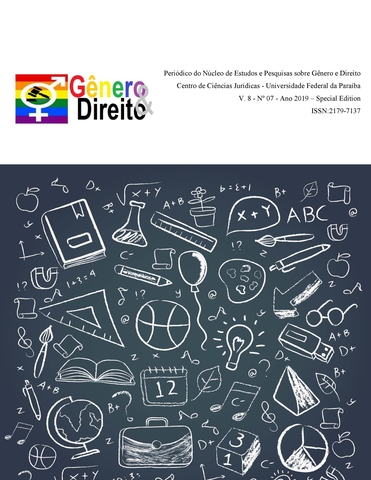CORPUS OF TITLE UNITS OF RUSSIAN-FOREIGN LANGUAGE REFERENCE BOOKS
DOI:
https://doi.org/10.22478/ufpb.2179-7137.2019v8n7.49952Palavras-chave:
bilingual linguography, vocabulary, dictionary, macrostructure, Russian languageResumo
The object of research is linguistic informativity of the macrostructure of language reference books. The research material is bilingual (Russian-Tatar and Russian-Chinese) dictionaries of various types of the end of the 20th – beginning of the 21st cc. The paper presents the classification including various features of the existing bilingual dictionaries. Bilingual linguography comprises various types of anguage reference books. Most of the language reference books analyzed in this paper are monoscopal, with one source language and one target language. One of the key notions of linguography, as well as the essential component of a language reference book, is the vocabulary. One has to admit that in the modern linguography there is still no distinct objective criterion for selecting words for a language reference book. When composing a vocabulary, subjective factors play a great role. When researching the Russian-foreign language reference books, we revealed a number of mistakes and drawbacks referring to the vocabulary: a) unjustified inclusion of units into the vocabulary, b) unjustified absence of units in the vocabulary, c) orthographic mistakes, d) incorrect use of illustrative material (pictures, photos, etc.). There is no single established opinion as to what information a learner’s dictionary should include. It is important to remember that inclusion of specific information depends on the dictionary’s addressee and purpose.
Downloads
Referências
Mugglestone L.The Oxford History of English. Oxford University Press, 2012.- 624 р.
Durkin Ph. (ed.). The Oxford Handbook of Lexicography. Oxford University Press, 2015. 736 p.
Xiangqing Wei et al. Lexicography in China (1978-2008). Beijing: The Commercial Press, 2014. VI + 445 p.
Ashrapova, A.H., Yusupova, A.S. Language and national identity in linguistic dictionaries (on material of bilingual dictionary of the Tatar language of the 19th century and the turn of the 20th century) // Journal of Language and Literature, Volume 6, Issue 1, 2015, pp. 318-321.
Galiullin K., Gorobets E., Martyanov D. Electronic terminological thesaurus in the information support of linguistics // SGEM 2014 International Multidisciplinary Scientific Conferences on Social Sciences and Arts, 1 – 10 September 2014, Section Education & Educational Research, pp. 273-280.
Islamova Elvira A., Svetlana S. Safonova, Ramzia M. Bolgarova. Written records of the Kazan region of the XVI century: historical, lexicological and lexicographical aspects. Journal of Language and Literature 2014; 5(4), рр. 321-324. DOI: 10.7813/jll.2014/5-4/68
Solnyshkina M., Gafiyatova E. Modern Forestry English: Macro- and Microstructure of Low Register Dictionary // Journal of Language and Literature, 2014, 5 (4), pp. 220-224.
Karimullina R.N. (comp.), Galiullin K.R. (ed.). Tatar lingougraphy: dictionaries of the Tatar language of 1951-2008: bibliographic reference book. Kazan, 2011. 536 p.
Berkov V.P. Bilingual lexicography: tutorial. Moscow: AST: Astrel, 2004. 236 p.
Baranov A.N. Introduction to applied linguistics: tutorial. Moscow: Editorial URSS, 2001. 360 p.
Galiullin K.R., Karimullina G.N., Karimullina R.N. Linguographic classes in language reference books of the 21st century. In: K.R. Galiullin, E.A. Gorobets, A.A. Nikolaev (eds.). Works and materials of International Conference “I.A. Baudouin de Courtenay and the world linguistics”, 5th Baudouin Readings (Kazan Federal University, 12–15 October 2015). In 2 vol. Kazan: Kazan Federal University, 2015. Vol. 2. Pp.64-66.
Kuznetsov S.A. (ed.). Grand Thesaurus of the Russian Language. Saint Petersburg: Norint. 1998.
Kord, H., Noushiravani, Y., Bahadori, M. D., & Jahantigh, M. (2017). Review and Analysis of Telework Perspective in the Administrative Systems. Dutch Journal of Finance and Management, 1(2), 44. https://doi.org/10.29333/djfm/5820
Mazurova, E. (2017). Exploratory Analysis of the Factors Affecting Consumer Choice in E-Commerce: Conjoint Analysis. Journal of Information Systems Engineering & Management, 2(2), 12. https://doi.org/10.20897/jisem.201712
Sears, R. (2018). The Implications of a Pacing Guide on the Development of Students Ability to Prove in Geometry. International Electronic Journal of Mathematics Education, 13(3), 171-183. https://doi.org/10.12973/iejme/3835
Shatilova, L. M., Borisova, V. V., & Kasatkina, O. A. (2018). Representation of the linguistic and cultural concept “lie” in the French and Russian language picture of the world. Opción, 34(85-2), 257-276

